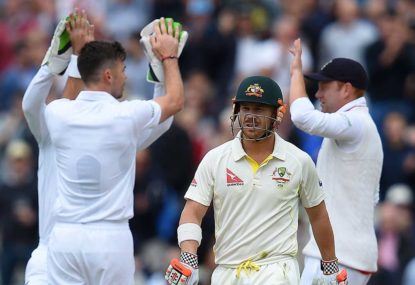Of the all the batsmen to have played more than 20 innings across Test cricket’s 138-year history just 43 boast an average over 50.
In each decade there has been a very select group of batsmen who have been members of the 50-plus club.
Across the 1970s and 1980s, for example, there were just five batsmen who averaged more than 50 – Greg Chappell, Javed Miandad, Viv Richards, Sunil Gavaskar and Allan Border.
Gary Sobers did too, however he retired in 1974.
Roll the clock forward a few decades and it is a very different story. In the last 15 years we have seen an explosion in the number of batsmen who have averaged 50-plus.
In the last five years alone we have seen eight players head into retirement with a 50-plus average: Kumar Sangakkara (57.4), Jacques Kallis (55.4), Sachin Tendulkar (53.7), Rahul Dravid (52.3), Mohammad Yousuf (52.3), Ricky Ponting (51.8), Michael Hussey (51.5) and Shivnarine Chanderpaul (51.4).
Added to that list are long-term players who are still in action like Younis Khan (53.9), AB de Villiers (52.1) and Hashim Amla (51.7).
Some of those 43 who average more than 50 are currently playing and a long way from retirement – Steve Smith (56.1), Joe Root (54.9) and David Warner (51.3), to name three. Others have recently retired just shy of the 50-run mark – Mahela Jayawardene (49.8), Virender Sehwag (49.3), Michael Clarke (49.1) and Misbah-ul-Haq (48.9).
In short, the game has moved inexorably in favour of the batsmen in recent times.
Two of the major developments to aid the batsmen’s lot have been the advances made in bat technology and the roped off boundaries, which on grounds like the MCG can in places shorten the boundary by up to 15 metres.
Mistimed shots with old-fashioned bats that would see a batsman caught are nowadays often caught by the crowd.
The arms race has been all one way, too. While the batsman’s weaponry has been pretty much allowed to develop unhindered the bowler’s weapon has remained unchanged for decades.
The old 5.5 ounce (156 gram) cork-filled, twine-wrapped and leather-bound hand-stitched projectile has remained in vogue while bats have become bazookas and grounds have shrunk. One could also argue that batsmen friendly pitches greatly outnumber the often seen green tops of yesteryear.
While a 50-plus average put a player in rarefied air the same applied to bowlers who averaged under 25. Yet while so many batsmen continue to head north of 50, fewer and fewer bowlers are operating under 25.
The MCC is largely responsible for the swing in the balance of power. The question is, will they do anything about levelling the playing field?
In some ways the pink ball experiment at the Adelaide Oval may help. It is generally perceived that the bowlers will be the beneficiaries of the different ball.
Anecdotally it swings more and then when it darkens and the seam discolours it is difficult for batsmen to pick the spinners. But that in itself is going to be of only limited value.
It is unlikely that Test cricket will move rapidly to a situation where the bulk of matches are played as day-nighters and in some parts of the cricketing world atmospheric conditions do not favour such a transition.
Aside from putting in place a halt to bat development and issuing a set of standards with respect to the depth of the bat a move should be made immediately to pushing back the ropes to a standardised distance from the fence, one that allows for player safety only.
It may also be time to look at the number of overs that need to be bowled before a new ball can be taken. Currently that number stands at 80. Perhaps a reduction to something like 65 overs would be preferable.
There would be times when captains would not avail themselves of the earlier opportunity should their pace bowlers be producing threatening reverse swing or their spinners making the most of the conditions with an older ball. However, the prospect of being able to ‘rearm’ 15 overs earlier would often be valuable.
How often do we hear commentators saying on the opening day of a Test, when the bowling side has struggled for wickets and bled runs, that they should take the second new ball only a few overs before stumps so they could use it primarily the next day with a rejuvenated pack of bowlers?
Yet if there was an option to reload at 65 overs the fielding side would have close to a full session to try and get back into the game.
Too often nowadays the team that wins the toss and bats is accorded a massive advantage by setting up the match on an often benign surface.
Surely something has to be done to try and bring the balance of the game back to a more even keel. For over the past decade the pendulum has swung way too much in favour of the batsmen.
So what do you consider, Roarers, would be some ways of bringing the game of Test cricket back to a more even duel?





























































































